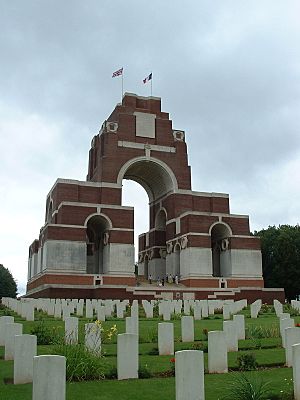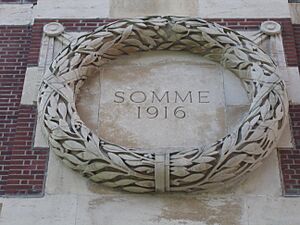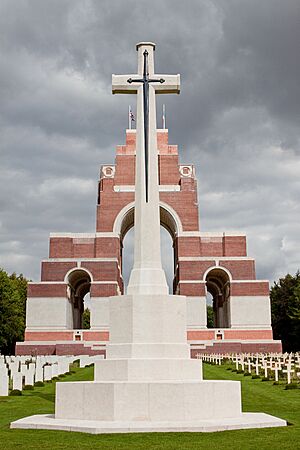Thiepval Memorial facts for kids
Quick facts for kids Thiepval Memorial to the Missing of the Somme |
|
|---|---|
| Commonwealth War Graves Commission | |

The Thiepval Memorial to the Missing of the Somme
|
|
| For the dead of the Battles of the Somme of the First World War with no known grave | |
| Unveiled | 1 August 1932 by Edward, Prince of Wales |
| Location | 50°3′2″N 2°41′9″E / 50.05056°N 2.68583°E near Thiepval, northern France
|
| Designed by | Sir Edwin Lutyens |
| Commemorated | 73,337 |
|
Here are recorded names of officers and men of the British Armies who fell on the Somme battlefields July 1915 February 1918 but to whom the fortune of war denied the known and honoured burial given to their comrades in death.
|
|
| Official name: Funerary and memory sites of the First World War (Western Front) | |
| Type: | Cultural |
| Criteria: | i, ii, vi |
| Designated: | 2023 (45th session) |
| Reference #: | 1567-SE03 |
| Statistics source: Cemetery details. Commonwealth War Graves Commission. | |
The Thiepval Memorial to the Missing of the Somme is a huge war memorial in France. It honors over 72,000 British and South African soldiers. These brave men fought in the First World War's Battle of the Somme. They died between 1915 and 1918 and have no known grave.
The memorial is located near the village of Thiepval in Picardy, France. A special visitors' center opened there in 2004. Sir Edwin Lutyens designed this amazing structure. Many people call it one of the greatest British monuments of the 20th century.
Contents
Where is the Memorial Located?
The Thiepval Memorial stands about 200 meters (about 650 feet) southeast of the old Thiepval Château. The château was on lower ground, next to Thiepval Wood. The memorial was not built on the château's exact spot. This was to avoid moving graves dug around wartime medical stations.
Designing and Opening the Memorial
Sir Edwin Lutyens designed this important memorial. It was built between 1928 and 1932. It is the largest memorial in the world for missing soldiers from the Commonwealth of Nations.
The Prince of Wales (who later became King Edward VIII) officially opened it. The opening ceremony happened on August 1, 1932. The President of France, Albert Lebrun, was also there. Lutyens, the designer, attended the event too. This was the last of the special memorials in Flanders and Picardy to be opened.
What Does the Memorial Look Like?
The memorial is very tall and stands out in the countryside. It has 16 large brick pillars covered with Portland stone. It was first built with French bricks from Lille. But in 1973, it was refaced with Accrington brick.
The main arch faces east to west. The memorial is 140 feet (about 43 meters) tall above its base. Its foundations are 19 feet (about 5.8 meters) thick. These strong foundations were needed because of all the tunnels dug during the war.
The memorial has a unique design with many interlocking arches. There are arches of four different sizes. Each side of the main arch has a smaller arch. These smaller arches are at a right angle to the main one. Even smaller arches pierce the sides of these, and so on.
This design creates 16 pillars. These pillars have 64 stone panels. Only 48 of these panels have names carved on them. The panels on the outside of the memorial are blank.
A historian named Stephen Games described the memorial. He said it looks like two triumphal arches crossing each other. The arches on the east-west sides are taller. All of this is built on a square grid plan. A tower sits on top of the main arch. In the center of the memorial, there is a Stone of Remembrance.
The memorial holds the names of 72,246 officers and men. Lutyens' clever design helped fit all these names. Other memorials for missing soldiers, like those at Loos or Arras, are longer and lower.
Names and Inscriptions
Only the names of missing or unidentified soldiers are carved on the memorial. These are soldiers who have no known grave. A large message inside the memorial reads:
Here are recorded
names of officers
and men of the
British Armies who fell
on the Somme battlefields
July 1915 February 1918
but to whom
the fortune of war
denied the known
and honoured burial
given to their
comrades in death.
The names of over 72,000 men are carved on the Portland stone pillars. These men were lost in the Somme battles between July 1915 and March 1918. The Commonwealth War Graves Commission says that over 90% of these soldiers died in the first Battle of the Somme in 1916. The names are carved in a special uppercase style designed by MacDonald Gill.
What Happens When a Soldier is Found?
Over the years, bodies have been found on the old battlefield. Sometimes, they can be identified. To keep the memorial only for the missing, a decision was made. If a body is found and identified, their name is removed from the memorial. The carved name is filled in with cement.
Soldiers who are found and identified get a full military funeral. This happens at a cemetery near where they were discovered. This practice has created many empty spaces in the lists of names.
Other Important Inscriptions
On top of the archway, there is a French message. It says: "Aux armées Française et Britannique l'Empire Britannique reconnaissant". This means "To the French and British Armies, from the grateful British Empire." Just below this, the years 1914 and 1918 are carved. On the upper edges of the side arches, it says "The Missing / of the Somme."
The memorial also has sixteen stone laurel wreaths. These wreaths are carved with the names of smaller battles. These battles were part of the Battle of the Somme. The men honored at Thiepval died in these fights. One wreath is simply called 'Somme 1916'.
Other battle names on the wreaths include:
- Ancre Heights
- Ancre
- Albert
- High Wood
- Delville Wood
- Morval
- Flers–Courcelette
- Pozières Wood
- Bazentin Ridge
- Thiepval Ridge
- Transloy Ridges
- Ginchy
- Guillemont
The last two wreaths are for 'Bapaume' and 'Miraumont'. These likely refer to battles in 1917. The Thiepval Memorial includes those who died before March 20, 1918. For example, the Actions of Miraumont happened in February 1917. Bapaume was taken by the British in March 1917.
Famous People Honored Here
Many notable people are listed on the memorial. Seven soldiers who received the Victoria Cross are remembered here. The Victoria Cross is the highest award for bravery in the British military.
- Eric Norman Frankland Bell
- William Buckingham
- Geoffrey St. George Shillington Cather
- William McFadzean
- William Mariner
- Thomas Orde Lawder Wilkinson
- Alexander Young (from South Africa)
Other famous people honored include:
- English cricketer Alban Arnold
- English cricketer Sydney Thomas Askham
- Composer George Butterworth
- Irish cricketer William Crozier
- Scottish rugby player Rowland Fraser
- English cricketer John Gregory
- England rugby player and clergyman Rupert Inglis
- Irish economist, poet, and politician Thomas Michael Kettle
- England rugby player John Abbott King
- Irish soccer player Jimmy Maxwell
- England rugby player Alfred Maynard
- Scottish rugby player Eric Milroy
- Welsh soccer player Leigh Richmond Roose
- English writer Saki (Hector Hugh Munro)
- English cricketer Ernest Shorrocks
- Welsh rugby player Dick Thomas
- Welsh rugby player Horace Thomas
- Musician and composer Francis Purcell Warren
- Welsh rugby player David Watts
A Memorial for Two Nations
The Thiepval Memorial also honors the joint effort of French and British forces. They fought together in the 1916 offensive. To show this, there is a cemetery at the memorial's base. It's called Thiepval Anglo-French Cemetery. It has 300 graves for British Commonwealth soldiers and 300 for French soldiers.
Most of the soldiers buried here are unknown. Their bodies were found between 1931 and 1932. Many came from the Somme battlefields. Some were found as far north as Loos and as far south as Le Quesnel.
The British Commonwealth graves have rectangular white headstones. The French graves have grey stone crosses. For unknown soldiers, British headstones say "A Soldier of the Great War / Known unto God". French crosses simply say "Inconnu" ('unknown').
The cemetery's Cross of Sacrifice has a special message. It recognizes the shared sacrifice of both nations:
That the world may remember the common sacrifice of two and a half million dead, here have been laid side by side Soldiers of France and of the British Empire in eternal comradeship.
Ceremonies and Services
Every year on July 1st, a big ceremony is held at the memorial. This date is the anniversary of the first day on the Somme. There is also a ceremony on Remembrance Day, November 11th, starting at 10:45 AM (Central European Time).
See also
- World War I memorials



